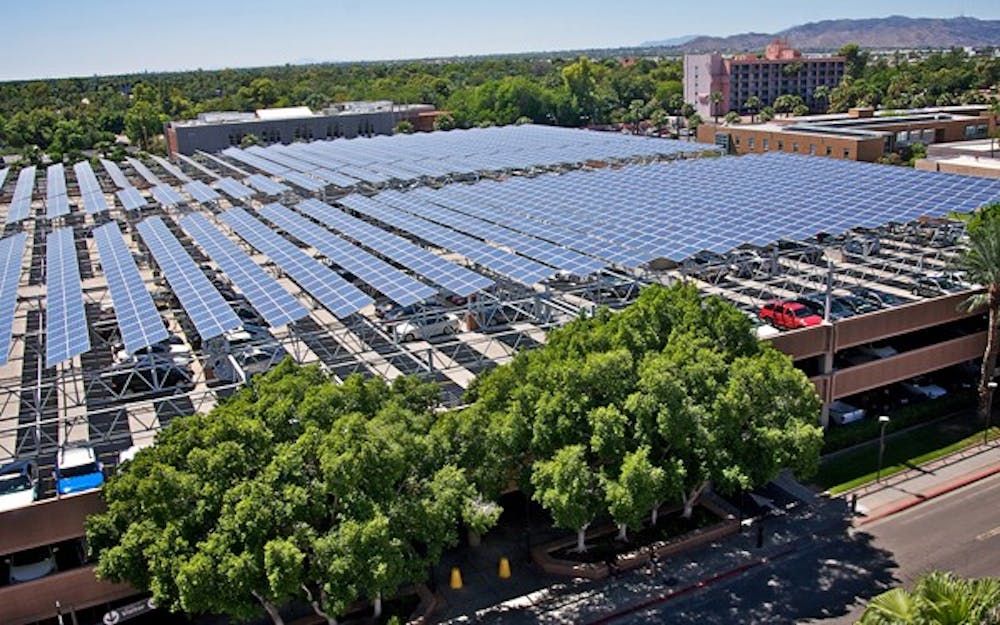 The Apache Boulevard parking structure is one of the many buildings at ASU that is powered by solar energy. ASU recently received funding from the U.S. and Australia to further solar energy research and technologies. (Photo Courtesy of the Office of Knowledge Enterprise Development at ASU)
The Apache Boulevard parking structure is one of the many buildings at ASU that is powered by solar energy. ASU recently received funding from the U.S. and Australia to further solar energy research and technologies. (Photo Courtesy of the Office of Knowledge Enterprise Development at ASU)ASU and Australian researchers are collaborating to create new solar technologies during the next few years. ASU is among one of the universities included in the United States Solar Energy Collaboration with the Australian Renewable Energy Agency.
ASU is not only the largest institution in the U.S., but it is also working on advancing solar energy, said Liping Wang, project leader and mechanical engineering associate professor.
“Solar energy is renewable, it’s abundant and there is zero pollution,” Wang said.
The solar projects are part of ASU’s LightWorks Initiative which focuses on transforming the use of energy and sunlight to create valuable outcomes. The projects commenced their first meetings this year and are multimillion-dollar projects.
One of the projects, the Micro Urban Solar Integrated Concentrators, is set to last about three years. The project would produce a micro solar thermo collector that can be placed on the roof of an urban building. The collector would create enough solar energy to heat all of a building’s domestic hot water needs.
Senior sustainability scientist and professor Harvey Bryan is one of the co-project investigators, along with University faculty members Pat Phelan, Lenore Dai, Robert Wang and Liping Wang.
Bryan said the research will be done both in Australia and at ASU to perfect the design for the system.
“I think we’re going to have prototypes in both countries, and we’re going to test versions here and in Australia,” Bryan said. “We’re going to compare the results of our findings, have a couple of prototypes made and we’re going to be testing them for their performance over the duration of the project simultaneously.”
ASU LightWorks Deputy Director Ellen Stechel is involved in the Australian Solar Thermal Research. The project focuses on researching how to make power from the sun more efficient and affordable. Stechel said ASU is the only university partner collaborating on the project.
ASU is also involved with the U.S.-Australia Institute for Advanced Photovoltaics. This project absorbs the sun’s protons and turns them into electricity. Stechel said it would create a solar plant that would turn heat into power directly from the sun.
An additional project is Solar to Fuels, which will create fuels from the sun, replacing the use of fossil fuels.
Stechel said the solar fuels would directly convert the sun's energy into chemical energy without invoking biological processes, organisms or plants. It would be direct absorption from the sun with carbon dioxide, water and solar fuels, Stechel said.
“The idea with solar fuels is to make equivalent fuels, gasoline, diesel or jet fuels, so it can go into today’s infrastructure and today’s engines,” Stechel said.
The infrastructure would allow a smooth transition from fossil energy to solar energy and ultimately sustainable fuels, Stechel said.
She said projects are intended to build collaborations between the two countries.
“There is a bilateral commitment for the two countries to work together on solar energy especially between Australia and Arizona,” Stechel said. “We have some similarities in our environment and some of our challenges will be applicable to Australia and vice versa.”
Reach the reporter at jcsolis@asu.edu or follow her on Twitter @jackiecsolis




